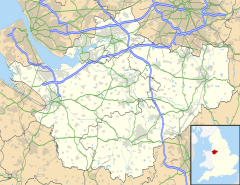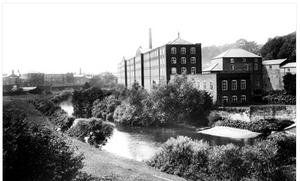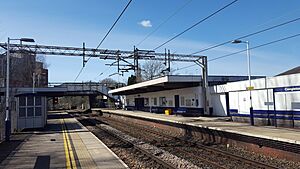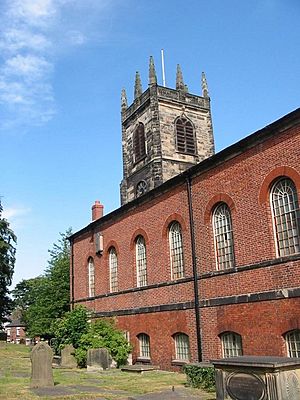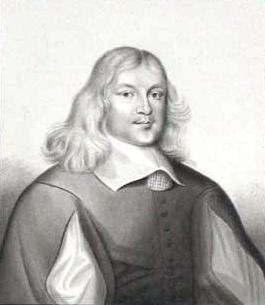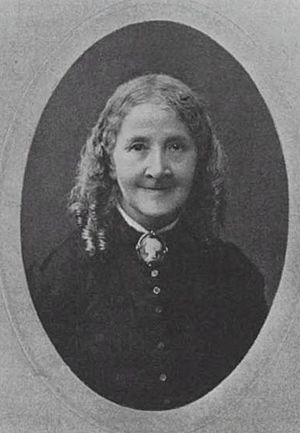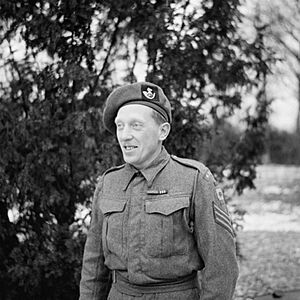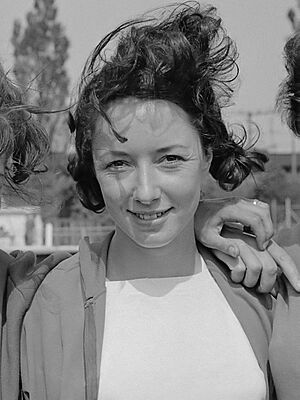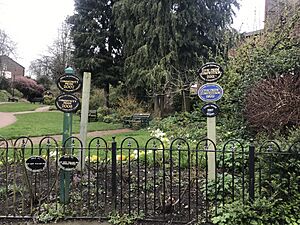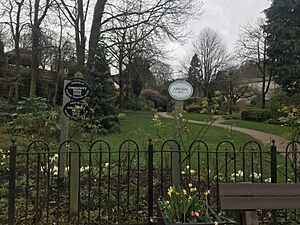Congleton facts for kids
Quick facts for kids Congleton |
|
|---|---|
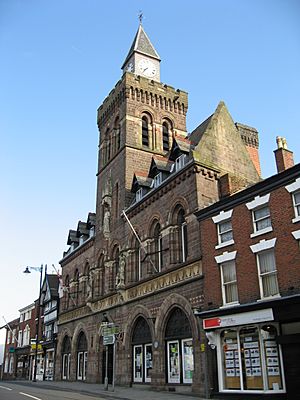 Congleton Town Hall, completed 1866 |
|
| Population | 30,015 (2021 Census) |
| OS grid reference | SJ854628 |
| Civil parish |
|
| Unitary authority |
|
| Ceremonial county | |
| Region | |
| Country | England |
| Sovereign state | United Kingdom |
| Post town | CONGLETON |
| Postcode district | CW12 |
| Dialling code | 01260 |
| Police | Cheshire |
| Fire | Cheshire |
| Ambulance | North West |
| EU Parliament | North West England |
| UK Parliament |
|
Congleton is a lively market town and civil parish located in Cheshire, England. It sits by the River Dane, about 21 miles (34 km) south of Manchester and 13 miles (21 km) north of Stoke on Trent. In 2021, about 30,015 people lived here.
Contents
- What's in a Name? The Origin of Congleton
- A Journey Through Time: Congleton's History
- How Congleton is Governed
- Where is Congleton? Geography and Areas
- What Congleton Makes: Economy and Industry
- Fun Things to Do: Culture and Leisure
- Getting Active: Sports in Congleton
- Getting Around: Transport in Congleton
- Important Services: Public Services
- Places of Worship: Religion
- Learning in Congleton: Education
- Famous Faces: Notable People from Congleton
- Friends Across the World: Twin Town
- Special Honors: Aldermen and Freeman
- Awards and Recognition
- Images for kids
- See also
What's in a Name? The Origin of Congleton
The name "Congleton" first appeared in records in 1282, spelled Congelton. We don't know exactly where the name came from. Some people think "Congle" might come from an old Norse word, kang, which means "a bend". The "ton" part comes from an Old English word, tun, meaning "settlement" or "town".
A Journey Through Time: Congleton's History
Congleton has a very long history, with the first settlements dating back to the Neolithic (New Stone Age) period. Tools and items from the Stone Age and Bronze Age have been found here.
Early Days and Charters
The town was once owned by Godwin, Earl of Wessex during the Saxon times. Congleton is even mentioned in the Domesday Book, a famous survey from 1086. In the 13th century, the de Lacy family owned Congleton.
In 1272, Henry de Lacy, 3rd Earl of Lincoln gave Congleton its first special permission, called a charter. This allowed the town to hold fairs and markets. It also gave them the right to choose a mayor and have a special group called a merchant guild.
The Great Flood and Rebuilding
In 1451, the River Dane flooded badly. It destroyed many buildings, including the town's mill and a wooden bridge. After the flood, the river was moved, and the town was rebuilt on higher ground.
The "Beartown" Legend
Congleton became famous in the 1620s for its love of bear-baiting, a popular sport back then. The town needed a new, strong bear to attract crowds. Legend says that Congleton used money saved for a new bible to buy a bear instead! They then earned back the money from the bigger crowds.
This story led to the folk song "Congleton Bear" by John Tams, which includes the line:
- Congleton Rare, Congleton Rare
- Sold the Bible to buy a bear.
Because of this legend, Congleton earned its fun nickname: 'Beartown'.
The English Civil War and a Famous Judge
During the English Civil War, a former mayor and lawyer from Congleton, John Bradshaw, became very important. He was the head of the court that decided the fate of King Charles I in 1649. Bradshaw's signature was the first on the document that led to the king's execution.
You can find a plaque on Bradshaw House in Lawton Street that remembers him. The White Lion public house also has a special plaque, saying it might have been where John Bradshaw worked as a lawyer.
Mills and Industry
King Edward I gave permission for a mill to be built in Congleton. The town grew into an important center for making textiles, especially leather gloves and lace. In 1753, the Old Mill was built, one of the first silk throwing mills.
More mills followed, and cotton was also spun here. The town's success depended on special taxes on imported silk. When these taxes were removed in the 1860s, many mills changed to making other fabrics. A small silk ribbon industry lasted into the 20th century. Today, many old mills are used for businesses or homes.
The beautiful town hall, designed in the Gothic style, was finished in 1866.
How Congleton is Governed
Congleton is part of the Cheshire East local government area. It also has its own elected Town Council, which started in 1980. The town is divided into two areas, and 20 councillors are chosen every four years to represent the people.
Congleton is also part of the Congleton parliamentary constituency. This area chooses one Member of Parliament (MP) to represent them in the UK Parliament. The current MP is Sarah Russell.
Where is Congleton? Geography and Areas
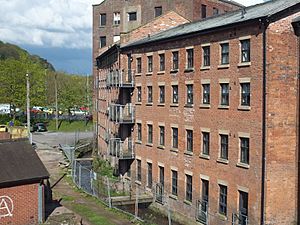
Congleton is located in a river valley, with the River Dane flowing through it. The town is divided into several main areas by the people who live there. These include Buglawton (sometimes called "Bug Town"), Bromley Farm, Mossley, Hightown, West Heath, Lower Heath, and the town center.
South of the town, there's a large green area called Priesty Fields. This natural space stretches right into the heart of the town, which is quite special for an English town.
What Congleton Makes: Economy and Industry
Today, Congleton's main industries include making airbags and golf balls. There are also light engineering factories nearby. Sand is also dug up from the Cheshire Plain.
One very important company in the past was Berisfords Ribbons, started in 1858. They made ribbons and had offices in many big cities.
Congleton Market is open every Tuesday and Saturday at the Bridestones Centre. Until around 2000, special billiard balls called Super Crystalate balls were made in Congleton.
Fun Things to Do: Culture and Leisure
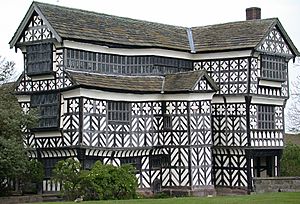
Just 4 miles (6.4 km) south-west of Congleton is Little Moreton Hall, a famous National Trust Tudor house. It's a great place to visit and see how people lived long ago.
Congleton Park is a lovely green space along the River Dane. It has a paddling pool that's open in the summer. Astbury Mere Country Park is also nearby, with a lake used for fishing and sailing.
For entertainment, Congleton has the 300-seat Daneside Theatre. The Clonter Opera Theatre is also close by. The Congleton Choral Society is a choir that performs regularly.
Congleton Museum is in the town center and tells the story of Congleton's industrial past. It even has an ancient log boat and old gold and silver coins.
Congleton hosts a food and drink festival each year, celebrating local produce. There's also a jazz and blues festival. In 2019, the town held its first annual pride event.
In 2011, Congleton had a special event called "Bearmania." Over sixty 5-foot tall bear sculptures were placed around the town. More than 26,000 people came to see these unique bears!
Local Media
Congleton has its own weekly newspaper, the Congleton Chronicle. You can also listen to local radio stations like Silk Radio and Hits Radio Staffordshire & Cheshire. There's even an internet-only radio station called Congleton Radio.
Getting Active: Sports in Congleton
Rugby Union
Congleton is home to one of the oldest rugby union clubs in the country, started in 1860. The club once held a world record for playing the longest continuous game of rugby! They also have 'walking rugby' for older players and a ladies' team.
Football
The local football team is Congleton Town F.C., nicknamed the Bears. They play at Booth Street.
Tennis
Congleton Tennis Club is also very old, founded in 1890. It has nine courts, some with floodlights for evening games.
Other Sports
There are two cricket clubs, Congleton CC and Mossley CC. You can also find two golf clubs: the nine-hole Congleton Golf Club and the 18-hole course at Astbury. The Congleton Harriers running club meets weekly, and a 5K parkrun happens at Astbury Mere Country Park.
Getting Around: Transport in Congleton
Trains
Congleton railway station opened in 1848. It's on the line between Manchester Piccadilly and Stoke-on-Trent. Trains usually run every hour.
Buses
Congleton has several bus routes that can take you to nearby towns like Alsager, Macclesfield, and Crewe.
Roads
Congleton is about 7 miles (11 km) east of the M6 motorway. The town is also on the A34 main road, which connects Stoke-on-Trent and Manchester. Other important roads include the A54 to Buxton and the Peak District, and the A536 to Macclesfield.
Canals
The Macclesfield Canal, finished in 1831, goes through Congleton. It's 26 miles (42 km) long and is known for its elegant bridges. Congleton is one of the few places in Britain where a road, canal, and railway all cross each other in the same spot!
Air Travel
The closest airport to Congleton is Manchester Airport, which is about 20 miles (32 km) away.
Important Services: Public Services
Cheshire Constabulary provides policing in Congleton, with the main police station on Market Square. The Cheshire Fire and Rescue Service handles fire and rescue, with a station on West Road.
Congleton has a small hospital called Congleton War Memorial Hospital. For bigger medical needs, people go to Leighton Hospital in Crewe or Macclesfield District General Hospital.
Places of Worship: Religion
Congleton has many churches and places of worship for different Christian groups. The four Anglican churches are St John's, St Stephen's, St Peter's, and Holy Trinity.
Other places of worship in the town include:
- Congleton Community Baptist Church
- Brookhouse Green Methodist Church
- New Life Church
- Congleton Pentecostal Church
- Rood Lane Methodist Church
- Spiritualist Church
- St James' Anglican Church
- St Mary's Roman Catholic Church
- Trinity Methodist Church
- Congleton United Reformed Church
- Wellspring Methodist Church
- The Church of Jesus Christ of Latter-day Saints (Mormons)
Learning in Congleton: Education
Congleton has several schools for different age groups.
Primary Schools
- Astbury St Mary's C of E School
- Black Firs Primary School
- Buglawton Primary School
- Daven Primary School
- Havannah Primary School
- Marlfields Primary Academy
- Mossley CE Primary School
- St Mary's Catholic Primary School
- The Quinta Primary School
High and Secondary Schools
- Congleton High School
- Eaton Bank Academy
Special Schools
- Aidenswood School
- Esland Daven School
Famous Faces: Notable People from Congleton
Many interesting people have connections to Congleton:
- Saint Margaret Ward (died 1588) - A Catholic martyr.
- John Bradshaw (1602–1659) - The judge who led the trial of King Charles I.
- Elizabeth Wolstenholme (1833–1918) - A suffragist who worked for women's right to vote.
- George Harold Eardley (1912–1991) - Received the Victoria Cross, a very brave award.
- Ann Packer (born 1942) and Robbie Brightwell (1939–2022) - Olympic gold medal athletes.
- Alan Garner (born 1934) - A famous novelist known for his children's fantasy books.
- Jackie Oates (born 1983) - A folk singer and fiddle player.
- John Gimson - An Olympic Silver Medallist who lives in Congleton.
- Sarah Russell - The current MP for the Congleton area.
Friends Across the World: Twin Town
Congleton is twinned with Trappes, a town in France. They became twin towns on September 16, 1962.
Special Honors: Aldermen and Freeman
Some people in Congleton have been given special honors like "Alderman" or "Freeman" for their important contributions to the town. These titles recognize their service and dedication.
Awards and Recognition
Congleton has won several awards over the years, showing its strong community spirit:
- Civic Pride Award (1997)
- Civic Pride Competition (1999, 2001)
- Community Pride (2006, 2007, 2011, 2012)
- Little Gem (2011)
- Best Kept Village (2018)
- Best Kept Village Overall Winner (2018)
Images for kids
-
Bluebells at Dane-in-Shaw Brook SSI
See also
 In Spanish: Congleton para niños
In Spanish: Congleton para niños


